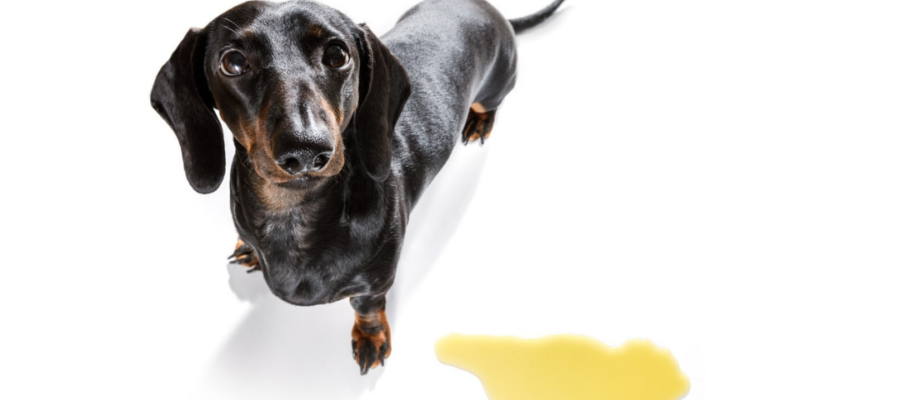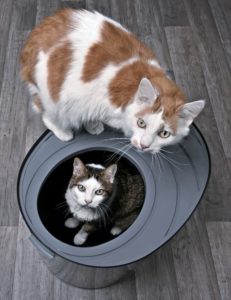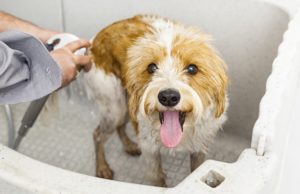Six Reasons Why Piddle Happens in Dogs and Cats

By Arden Moore – The Pet Health and Safety Coach™
For years, your dog or cat has dutifully had good bathroom habits. Suddenly, he starts urinating outside the litter box, on the living room rug or sigh, maybe even on your bed pillow. You may be puzzled, frustrated or a tad peeved. From your pet’s perspective, that yellow pool is no accident. It is a key clue that your pet may be dealing with a medical or behavior issue that merits your attention and possible treatment by your veterinarian.
“Many diseases, such as urinary tract infections, diabetes and kidney disease can cause changes in urinary patterns in cats and dogs,” says Dr. Julio Lopez, DVM, a board-certified internal medicine specialist in Los Angeles.
Changes in the household routine as well as facing a scary situation or feeling overly excited can also trigger a pet to piddle in the home. Although there is a myriad of reasons for house piddles, there are six common reasons every parent of a dog or cat should know.
MEDICAL CAUSES OF INAPPROPRIATE URINATION
Urinary tract infection
Any dog or cat of any age can develop a UTI, which can be painful and are often due to a bacterial infection.
Signs to watch: Pets suffering from UTIs cannot control when and where they urinate. The urine tends to give off a foul odor and may even contain blood.
Treatment: Your veterinarian most likely will take a urine draw from your pet’s bladder and analyze it, looking for the presence of bacteria and/or white blood cells that indicate inflammation. Antibiotics are often prescribed.
Diabetes
Basically, this disease surfaces because the pet’s pancreas is unable to produce enough insulin in the body to properly use sugars, fats and proteins.
Signs to watch: Pets developing this disease will begin to drink excessive amounts of water and urinate more often and in larger volumes. They may also have a cloudiness in their eyes, waning appetite and seem to be developing recurring skin infections.
Treatment: Diabetes is often confirmed after a veterinarian analyzes the urine and sees elevated levels of glucose and ketones. Managing diabetes may require the pet to switch to a therapeutic diet, be given regular exercise to maintain a healthy weight and possibly, daily insulin injections.
Kidney disease
The kidneys serve vital roles to maintain healthy blood pressure and hydration, produce urine, remove toxins and waste from the blood and manage red blood cell production. In cats and dogs, kidney issues can range from acute to chronic and can be life-threatening.
Signs to watch: Cats and dogs with kidney problems may need to urinate more frequently and uncontrollably. They can become dehydrated, lose weight, produce blood in their stools, vomit, have changes in their stools, and have bad breath. As kidney disease progresses, pets can be in severe pain.
Treatment: Depending on your pet’s condition, your veterinarian may give your pet intravenous fluids, electrolytes, and/or medicine to ease stomach upset. Your veterinarian may also recommend a therapeutic diet that is loaded with water-soluble vitamins, fiber, and antioxidants and is low in sodium and phosphorus.
BEHAVIORAL CAUSES OF INAPPROPRIATE URINATION
Cats and dogs crave predictability and thrive in homes that make them feel safe and protected. Disruptions in the household routine and feeling scared or overly excited can impact their bladder control.
“Fear can literally scare the pee out of a pup,” says Dr. Lisa Radosta, DVM, a board-certified veterinary behaviorist who operates the Florida Veterinary Behavior Services clinic in West Palm Beach, Florida. “Emotions are paired with physiologic responses and that can cause a dog or cat to urinate due to fear, anxiety, stress, and even excitement.”
Let’s look at these behavior-related reasons:
Disruptions in the pet’s daily routine
During this stubborn pandemic, people have spent more time at home, much to the delight of their bonded pets. But as pet parents return to their offices or take pet-free vacations, separation anxiety is bubbling up inside some cats and dogs. Some may urinate in the house while home alone as a way to self-calm. After all, the urine is a welcomed, comforting smell to them.
Strategies: Ensure your dog or cat receives physical and mental exercise daily. Ease in a professional pet sitter or dog walker to care for your pet while you take a few hours away from home. Avoid making a big deal out of leaving or coming home because your pet is tuned into your emotional state. Baby talk or apologies for leaving can cause some panic-striken pets to piddle in the home.
 Feelings of threat by the arrival of a new pet
Feelings of threat by the arrival of a new pet
Some resident cats or dogs may suddenly have “accidents” in the house as a territorial response to the arrival of a new pet they may not readily welcome.
Strategies: If you adopted a new pet, make sure there are ample resources in your home, including new toys, new beds, placement of litter boxes in different rooms and possibly, an additional cat tree and window perch so there is no perceived competition for these coveted pet items. You may need to temporarily separate the pets while unsupervised. Do your best to spend short one-on-one times with each pet.
Submissive or excitement urination
Some dogs who may feel anxious or stressed about meeting a new houseguest may squat and urinate to signal that they pose no threats. Other adult dogs may get so jazzed by greeting their favorite person that they uncontrollably tinkle.
Strategies: For starters, avoid hitting or chiding your dog for this panic piddle as such actions will only hone in fear and a need to pee response. Focus on giving low-key greetings with slow movements, a calm voice tone and angle your body so the dog is not motivated to leap up and energetically say hi. Consider tossing a treat, away from you as a reward for a polite, pee-free greeting.
HEALTH CONCERNS FOR PETS WITH PIDDLE PROBLEMS
For pets with potty issues, don’t overlook two additional health concerns: keeping their bodies clean and keeping tabs on their dental health, especially when certain medications are prescribed to help manage the medical or behavioral causes.
 Bathing
Bathing
Cats and dogs who are obese, suffer from arthritis, or are weakened by advanced age, may not be able to potty cleanly. They may need your help to clean their bums of urine or feces that can mat fur and even cause skin irritations or infections if it goes undetected, dries and becomes caked-on.
Strategies: Assemble all your supplies in the bathroom to effectively clean away the urine-soaked hair – a dampened washcloth, a thick towel, a quality shampoo designed specifically for pets a handful of treats for cooperation. My go-to choice for a cleanser is the ZYMOX® Shampoo. Why? Because this mild shampoo is pH-balanced and contains enzymes that control microbial growth on the coat and moisturizing Vitamin D. It is also free of any harsh detergents or harmful by-products, such as parabens that can harm the skin and coat. Looking for bathing tips? Please click here.
Dental Care
Medications may be prescribed to help manage the underlying cause of piddle problems. While those medications are needed to help pets manage medical and/or behavioral causes, some medications are not without side effects that can impact a pets’ oral health. Many commonly prescribed medications can cause a condition known as Xerostomia, aka dry mouth. Just like people, pets can get dry mouth too. Overtime, dry mouth can lead to bad breath and an overgrowth of bacteria or fungus in the mouth. This can lead to periodontal disease, mouth pain, and even tooth loss.
Strategies: Topping the list is providing fresh water daily. Also, practicing daily oral care on your pet. Use a veterinarian-recommended line of oral care products, such as Oratene® Brushless Oral Care, to help balance the oral flora, eliminate odor-causing bacteria and remove plaque biofilm. To learn more about pet dry mouth, you can click here.
 To learn more about Arden Moore, click here.
To learn more about Arden Moore, click here.

